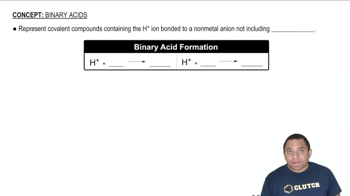Ch.23 - Organic and Biological Chemistry
Chapter 23, Problem 87
What does it mean to say that fats and oils are triacylglycerols?
 Verified step by step guidance
Verified step by step guidance1
Step 1: Understand the structure of triacylglycerols. Triacylglycerols, also known as triglycerides, are esters derived from glycerol and three fatty acids.
Step 2: Recognize the components. Glycerol is a three-carbon alcohol with three hydroxyl (OH) groups, and fatty acids are long hydrocarbon chains with a carboxylic acid group at one end.
Step 3: Learn the esterification process. In triacylglycerols, each hydroxyl group of glycerol forms an ester bond with the carboxyl group of a fatty acid, resulting in the release of water (a dehydration reaction).
Step 4: Differentiate between fats and oils. Both are triacylglycerols, but fats are typically solid at room temperature and are composed of saturated fatty acids, while oils are liquid and contain unsaturated fatty acids.
Step 5: Understand the biological significance. Triacylglycerols are a major form of energy storage in animals and plants, providing more energy per gram than carbohydrates or proteins.
Key Concepts
Here are the essential concepts you must grasp in order to answer the question correctly.
Triacylglycerol Structure
Triacylglycerols, also known as triglycerides, are esters formed from glycerol and three fatty acids. The glycerol backbone provides a central structure to which the fatty acids are attached via ester bonds. This unique structure allows triacylglycerols to serve as a major form of energy storage in living organisms.
Recommended video:
Guided course

Resonance Structures
Fatty Acids
Fatty acids are long hydrocarbon chains with a carboxylic acid group at one end. They can be saturated, containing no double bonds, or unsaturated, containing one or more double bonds. The type and arrangement of fatty acids in triacylglycerols influence their physical properties, such as melting point and state at room temperature (solid or liquid).
Recommended video:
Guided course

Binary Acids
Role of Triacylglycerols in Biology
Triacylglycerols play a crucial role in biological systems as energy reserves, providing more than double the energy per gram compared to carbohydrates. They also serve as insulation and protection for vital organs. Additionally, they are important in cellular signaling and the absorption of fat-soluble vitamins.
Recommended video:
Guided course

Inverse Logarithmic Functions
Related Practice
